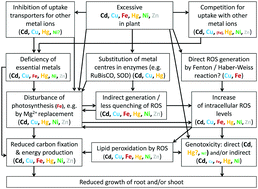Mechanisms of metal toxicity in plants
Abstract
Metal toxicity in plants is still a global problem for the environment, agriculture and ultimately human health. This review initially addresses the current state of the environmental/agricultural problem, and then discusses in detail the occurrence, mechanisms and relevance of toxicity of selected trace metals (Cd, Cu, Fe, Hg, Ni, and Zn). When discussing the mechanisms, special emphasis is laid on a critical review of their environmental/agricultural relevance, because even now many studies in this field of research are performed under highly artificial lab conditions. The main problems outlined in published studies are artificially high metal concentrations (which never occur even in highly polluted sites) combined with too short treatment times, as well as environmentally and agriculturally irrelevant growth conditions (e.g. constant light and submerged cultivation of seedlings). Furthermore, wherever possible an attempt is made to link the mechanisms published to date in terms of discussing which mechanisms are a direct cause of the observed disturbance of plant function and which are rather a consequence of the primary mechanisms, leading to a complicated toxicity phenotype and ultimately to diminished growth or even death of the plants.



 Please wait while we load your content...
Please wait while we load your content...